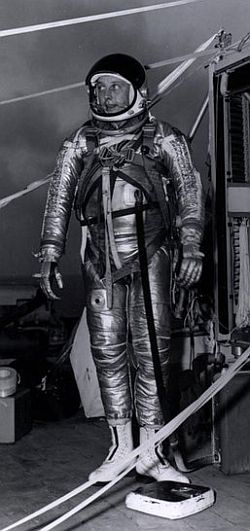 PRATHER, Victor A. (1923 - 1961)
PRATHER, Victor A. (1923 - 1961)

Lieutenant Commander Victor Alonzo Prather Jr. was an American flight surgeon involved in the early development of the first space suits.
He was born on June 4, 1923, in Lapeer, Michigan to Victor Prather Sr. and Gladys May Furse. He attended Tufts College in 1941, and graduated in 1945; then attended Tufts University School of Medicine, graduating there in 1952. After practicing civilian medicine for two years he rejoined the United States Navy in 1954. As a surgeon Prather served for three years abroad the aircraft carrier USS Shangri-La in the Mediterranean, stationed in Port Lyantey in Morocco. On return to the United States he completed courses in aviation medicine and served as Flight Surgeon in Pensacola, Florida, and in the western Pacific, out of Pearl Harbor, Hawaii Islands.
In 1960, Prather was transferred to Project RAM, a government program to test prototype space suits, at the Naval Medical Research Institute in Bethesda, Maryland. His mission was to test prototype astronaut flight suits against all forms of wear and pressures they would be subjected to while in earth orbit and in space. Prather tested spacesuits while under water for leaks, in low-pressure situations, and finally at very high altitudes.
In this later assignement he took part along with Commander Malcolm D. Ross, of the last manned flight of the Stratolab program which was launched from the aircraft carrier USS Antietam on May 4, 1961. The flight was carried off the coast of Pensacola, using an unpressurized gondola and was the more severe test of the Mark IV space suit. Also, personal telemeter systems for human vital signs and many other devices were tested for the first time.
The mission lasted 9 hours 54 minutes and reached a record altitude of 113.720 feet (32.6 km) landing at 16:02 in the calm waters of the Gulf of Mexico. A hovering helicopter departed from the Antietam and after reaching the gondola, lowered a rescue hook (or harness), and although Ross slipped partially out of it, he was able to recover without falling completely into the water. A few minutes later the helicopter returned to retrieve Prather. He climbed onto the rescue hook but was unable to secure himself. When the helicopter jerked upwards, he slipped off into the ocean. His flight suit then flooded, and he drowned before Navy divers could rescue him.
Prather was buried on May 10 1961, in the Arlington National Cemetery, Virginia, with full military honours.
Shortly after Prather's death, President John F. Kennedy phoned Prather's widow, Virginia Merritt, and she arrived at the White House with her children, Marla Lee Prather and Victor A. Prather III. Kennedy posthumously awarded Victor Prather the Navy Distinguished Flying Cross for 'heroism and extraordinary achievement'. The balloonists were also awarded the 1961 Harmon Trophy for Aeronauts.
In 1962, the American Astronautical Society established the Victor A. Prather Award "to promote understanding of high altitude environment on humans." It is awarded to researchers, engineers and flight crew members in the field of extravehicular protection or activity in space. The first year it was awarded to Prather's companion Commander Malcolm D.Ross.
The record set by both men in the last Stratolab mission is still officially recognized as unbeaten by the Fédération Aéronautique Internationale.

